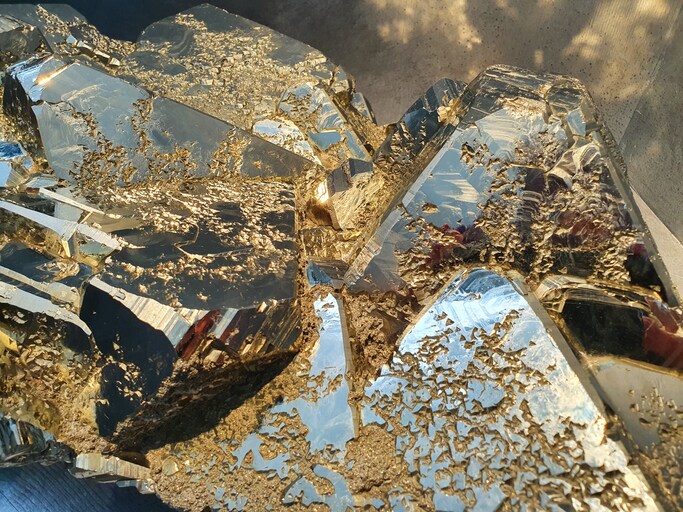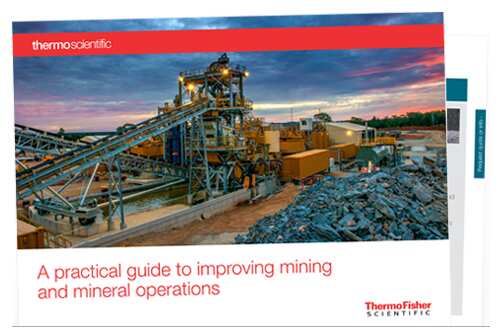
“Fool’s Gold” is technically known as pyrite or iron sulfide (FeS2) and is one of the most common sulfide minerals. Sulfide minerals are a group of inorganic compounds containing sulfur and one or more elements. Minerals are defined by their chemistry and crystalline structure. Minerals that have the same chemical composition but different crystal structures are called polymorphs.
Pyrite and marcasite, for example, are polymorphs because they are both iron sulfide, but each has a distinct structure. Minerals can also have the same crystalline structure but different elemental compositions, but it’s the crystal structure that determines the mineral’s physical characteristics.
In addition to pyrite, common sulfides are chalcopyrite (copper iron sulfide), pentlandite (nickel iron sulfide), and galena (lead sulfide). The sulfide class also includes the selenides, the tellurides, the arsenides, the antimonides, the bismuthinides, and the sulfosalts. Many sulfides are economically important as metal ores.
Pyrite is called “Fool’s Gold” because it resembles gold to the untrained eye. The United States Geological Survey (USGS) explains that “Fool’s Gold can be one of three minerals. The most common mineral mistaken for gold is pyrite. Chalcopyrite may also appear gold-like, and weathered mica can mimic gold as well. Compared to actual gold, these minerals will flake, powder, or crumble when poked with a metal point, whereas gold will gouge or indent like soft lead. In addition, actual gold will leave a golden yellow streak when scraped on a piece of unglazed porcelain. Pyrite and chalcopyrite will leave a dark green to black streak and the common micas will leave a white streak.” If you want to know more about how to tell real gold from “Fool’s Gold,”* watch this video produced by the University of Knottingham.
Pyrite is so named from the Greek word for fire (pyr) because it can create sparks for starting a fire when struck against metal or stone. This property made it useful for firearms at one time but this application is now obsolete. Pyrite was once a source of sulfur and sulfuric acid, but today most sulfur is obtained as a byproduct of natural gas and crude oil processing.
Today pyrite is sometimes sold as a novelty item or costume jewelry. But pyrite isn’t entirely useless; in fact it’s a good way to find real gold because the two form together under similar conditions. Gold can even occur as inclusions inside pyrite, sometimes in mineable quantities depending on how effectively the gold can be recovered.
Pyrite has long been investigated for its semiconductor properties. The American Chemical Society published a review on trends and challenges of iron pyrite in photovoltaics. The abstract notes; “Solar cells consisting of different materials have been introduced in recent years, and the overall performance defined by these materials has a lot of potential to increase. Transition metal dichalcogenides have gained significant importance due to their advantageous properties and promising potential. Iron disulfide or pyrite is one such material that has risen as a favorable material for photovoltaics cells owing to its suitable band gap, high absorption coefficient, and low cost.”*
Pyrite is found in a wide variety of geological settings, from igneous, sedimentary and metamorphic rock to hydrothermal mineral deposits, as well as in coal beds and as a replacement mineral in fossils. Pyrite can be either disseminated throughout igneous rock or concentrated in layers, depending on depositional mechanism and environment. Pyrite forms in sedimentary rocks in oxygen-poor environments in the presence of iron and sulfur. These are usually organic environments, such as coal and black shale, where decaying organic material consumes oxygen and releases sulfur. Pyrite often replaces plant debris and shells to create pyrite fossils or flattened discs called pyrite dollars.
In calcite and quartz veins, pyrite oxidizes to iron oxides or hydroxides such as limonite, an indicator that there is pyrite in the underlying rock. Such oxidized zones are called “gossan,” which appears as rusty zones at the surface. Gossans can be a good drilling targets for gold and other precious or base metals.
Pyrite is unstable and oxidizes easily, which is an issue in controlling acid mine drainage. Pyrite is a widespread natural source of arsenic, which can leach into ground-water aquifers when geologic strata containing pyrite are exposed to the air and water, during coal mining for example. Acid mine drainage and groundwater contamination requires close monitoring to ensure that it has been neutralized before being returned to the earth.
A question: If you have a shiny and tiny golden color spot in your sample, how would you identify it? Is it gold? Is it pyrite? Portable x-ray fluorescence (XRF) analyzers are an important tool in this effort. In just a few seconds, you can identify that ‘rock’. X-ray fluorescence spectroscopy (XRF) is a non-destructive analytical technique used to determine the elemental composition of materials. XRF analyzers work by measuring the fluorescent (or secondary) X-rays emitted from a sample when excited by a primary X-ray source. Each of the elements present in a sample produces a set of characteristic fluorescent X-rays, or “unique fingerprints.” These fingerprints are distinct for each element, making XRF analysis an excellent tool for quantitative and qualitative measurements. is a non-destructive analytical technique used to determine the elemental composition of materials.*
At the exploration stage, a quick, non-destructive analysis is often required for outcrop and soil analysis, advanced exploration and drilling, core sample analysis, mine mapping, grade control, and cuttings analysis for mud logging and reservoir characterization. This data can enable geologists and miners to make data driven decisions on locations & sites… helping them to not be fooled by this fake gold.*
Editor’s Note: This article was originally authored by Ali Somarin and published in April 2014 but has been refreshed and updated with information marked at the end of the paragraphs above with an asterisk (*).
Additional Resources:
- Visit our Mining and Mineral Operations center for information on improving product quality, maximizing resources, and gaining efficiencies.
 Download eBook: A Practical Guide to Improving Mining and Mineral Operations
Download eBook: A Practical Guide to Improving Mining and Mineral Operations
From mineral analysis to complete bulk weighing monitoring and sampling systems to informatics, discover the latest equipment and technology to help optimize your mining operations, and keep coal, cement, or mineral processing operations running smoothly, efficiently, safely, and profitably.






I recently discovered a very large mudslide which completely removed all river rock sands and gravel. What I found was very exciting. Exposed where there was once thousands of tons of earth was now rotten bedrock with a 60 foot long by about 4 feet wide bluish clay waterslide weaving through the bedrock. The bedrock contains alot of quartz. On the side walls that a day earlier were buried under ten feet of earth I see fine gravel streaks where thin areas of blue clay were worn away. There were little trails in the clay and they were filled with what I thought was fine gold. I began panning and this shiny brilliant color was heavy enough to be all that remained in the pan along with hundreds of garnets. So my question is this. The waters edge was stained with Rust.other elements found were rotten bedrock, blue clay, garnets, pyrite, copper flake, quartz and fine gravel which looks like it runs under the blue clay. Could I be close to finding gold and silver with all these historically gold bearing minerals found together in the same location.
Yep. Stick with it
MInecraft?
how is pyrite mined? How do people get it to make jewelry and such?
I have many iron pyrite where can I find the company in nigerian for sell
Here is a list of authorized distributors: https://www.thermofisher.com/us/en/home/industrial/spectroscopy-elemental-isotope-analysis/portable-analysis-material-id/portable-analysis-for-material-id-distributors.html?icid=CAD_blog_mining_2021Nov
If you don’t like cake then u must love pie right..:get it pyrite
How does pyrite come to be mined? How do people get it to produce things like jewelry and other items basket random?
Thank you for asking! Here’s the answer: https://www.thermofisher.com/blog/mining/from-mine-to-masterpiece-unveiling-the-journey-of-pyrite/